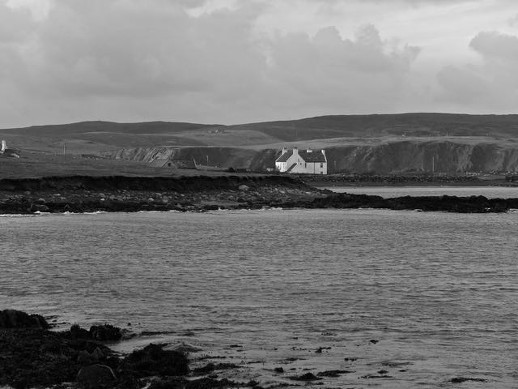Words and pictures by Tom Morton
Sand bags are not bags of sand, not in this neck of the bog. They are bags of grit, bags of gravel, sacks of small stones. Sand, sharp sand, builder’s sand? That would wash away, like the beaches sometimes do, sucked in and spat out by the biggest tides, wiped out by the wind.
The council has supplied us with gritbags, stonebags, gravelbags, and they are piled around the front door like the clusters of dead sheep you sometimes see, huddled against snowdrifted walls, revealed by the thaw. We wait.
We wait for the top of the tide. We wait for the flood.
We’ve done our best with this 300-year-old former Church of Scotland manse. The massive rock armouring along the shoreline was diggered in after the last major flood, in the late 1970s, when seawater was lapping a foot from the Rayburn’s top, according to Lornie, who was there, bailing, perched atop the stove with a bucket. The big stone house crouches on a beach, a shingle peninsula, just six metres or so from high water mark. And these days, the highest of high tides, the springs, are level with our doorstep on a calm day. So we have built extra walls, channels, drains and runnels to deal with the the malevolent storm surges that come with a couple of days of big Atlantic swells, building far out in the ocean and a wind of a particular, vicious bent. A westerly’s the one to watch for, when it starts backing, and great slurping, sloshing surges begin walloping around the bay. That’s when you’re looking at trouble. Or at night, listening for it, waiting.
The cast-iron Rayburn stove is a religion, surrounded by ritual, fear, hope, faith, deliverance, eternal hellfire. We burn peat, cut from our own banks. Sustainable? Probably not, not over 100,000 of your earth years, but more so than the Government-subsidised wood that is now fashionable and cheap on this treeless archipelago. Peat is local, hand-harvested over a backbreaking spring and summer. Peat is history. I’m think of Gunnister man, the 18th-century traveller found in mummified near perfection by cutters just a mile or two away. I’m think of ‘blue’ peat, the coal-like treasure that burns quickly and very hot, and the wet slabs of turf used to damp a fire that threatens to run out of control. Peat tar coats chimneys and if the lum catches, usually on a windy night, it’s like some kind of nuclear inferno that can, and does, melt stone.
This third-hand Rayburn, a Series 1 Landrover to a suburban Aga’s Range Rover Vogue, can be fine-tuned to handle the worst storm in the world. We’ve learned how to deal with it, finally, after hard, costly lessons involving the fire brigade, disastrous and dangerous sweeping attempts and leaking water jackets. Now, it’s hurricane proof. All flaps are closed. It’s our servant, not our flue-destroying master. Chim Chim Cheree! Water is croaking and bubbling in the backboilers, up the copper pipes to the radiators we bought from the old Peterhead Prison.
Tonight, it feels like the worst storm in the world is with us. But then, it often feels that way. In the downstairs toilet, the WC is waterless, the wind creating low pressure that sucks it dry. I pour a bucket down, for emergencies. It disappears in seconds.

